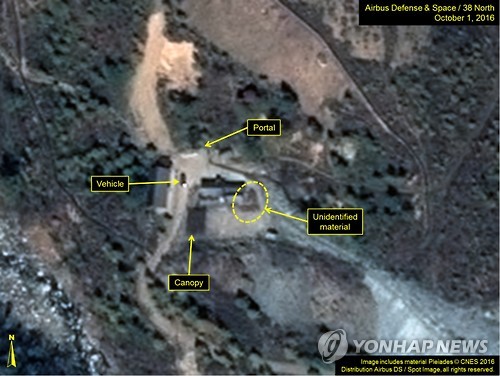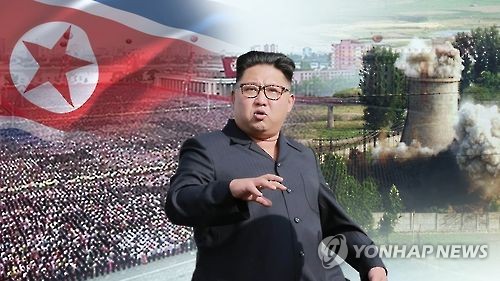- California Assembly OKs highest minimum wage in nation
- S. Korea unveils first graphic cigarette warnings
- US joins with South Korea, Japan in bid to deter North Korea
- LPGA golfer Chun In-gee finally back in action
- S. Korea won’t be top seed in final World Cup qualification round
- US men’s soccer misses 2nd straight Olympics
- US back on track in qualifying with 4-0 win over Guatemala
- High-intensity workout injuries spawn cottage industry
- CDC expands range of Zika mosquitoes into parts of Northeast
- Who knew? ‘The Walking Dead’ is helping families connect
S. Korea’s military on high alert ahead of key anniversary in N.K.
SEOUL, Oct. 7 (Yonhap) — South Korea’s military is on high alert as North Korea might stage another provocation to celebrate its key anniversary next week, government officials said Friday.
North Korea appears to be ready to carry out another nuclear test or launch a ballistic missile at any time given increased activities at its nuclear test and missile launching sites, military officials said.
“Chances are high that the North will conduct its sixth nuclear detonation or test-fire a ballistic missile ahead of the anniversary of its ruling Workers’ Party and the Security Consultative Meeting (SCM) scheduled in the U.S. later this month,” a defense ministry official told Yonhap News Agency.
The anniversary falls on Monday and defense chiefs of South Korea and the U.S. will discuss ways to ramp up the allies’ three-stage deterrence strategy, which could involve a pre-emptive strike option, during the annual meeting in Washington, D.C., on Oct. 20.
“Starting today, the military will maintain heightened vigilance against any provocations by the North,” the official said.

This commercial satellite imagery taken on Oct. 1, 2016, and offered by 38 North, a U.S. website monitoring North Korea, shows increased activity in the North’s Punggye-ri nuclear test site.
Seoul and Washington are closely watching developments over the weekend through U.S. intelligence, surveillance and reconnaissance (ISR) assets, which are crucial in detecting missile attack, another defense official said.
American ISR assets include the defense support program (DSP) which monitors the whole Korean peninsula around the clock and collects information from such assets as the U-2 spy plane and the E-8C JSTARS aircraft.
The unification and foreign ministries also said the government is fully prepared against provocations by the North and is fine-tuning contingency manuals tailored to each type of military provocation.
The government then said continuing activity at tunnels No. 2 and No. 3 at the Punggye-ri test site in the communist state’s northeast and giant canopies set up over entryways of these tunnels can indicate that another nuclear test is being prepared.
Pyongyang conducted its fifth underground nuclear test in tunnel No. 2 last month, while no detonation has been carried out in tunnel No. 3.
Commercial satellite imagery taken on Saturday of the test site “indicate continuing activity at all three tunnel complexes that could be used to conduct a nuclear test,” the website 38 North monitoring the North said Thursday.
The imagery shows a large vehicle, possibly a truck, near tunnel No. 2′s entrance, while a large canopy in its parking lot, which has been present for the past two months, remains in place. There appear to be stacks of boxes near the area, it said.
North Korea has conducted five nuclear tests in the past decade; two took place this year.

This undated Yonhap News TV image shows North Korean leader Kim Jong-un against the background of the communist state’s flag and a nuclear test capture.
Meanwhile, given increased activities at the Dongchang-ri rocket launching site in the North’s northwest, Pyongyang may be gearing up to launch a missile. The defense ministry said the North may launch either a medium-range Rodong or the more potent intermediate-range Musudan ballistic missile.
Pyongyang may fire Rodong and Mususan missiles from its transport erector launchers (TELs) capable of freely moving near the border with South Korea and hiding themselves from reconnaissance systems operated by Seoul and Washington in tunnels or mountains, it said.
In June, North Korea claimed the successful launch of an intermediate-range ballistic missile, saying it has the capacity to strike U.S. forces in the Pacific region.
But Seoul has not ruled out the possibility of Pyongyang firing a long-range ballistic missile, equipped with a new rocket engine, that could possibly reach the U.S. mainland.
In late September, the North claimed it successfully conducted a “ground test of a new type high-power engine for a rocket that can place a geo-stationary satellite around the Earth.” It said the engine has a thrust of 80 tons, which is three times the power of the engine used in its previous long-range rocket launches.











